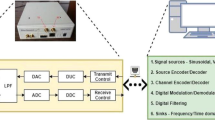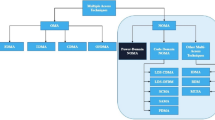Abstract
For last few years, the usage of bandwidth is being increased rapidly due to the growth of advanced applications and services. Therefore, it is required to depend on various multiple access techniques to maximize the spectrum efficiency. Non-orthogonal multiple access (NOMA) is recognized as a prominent technique to increase the spectrum utilization for upcoming wireless technologies. In this paper, the experimental validation of NOMA system is carried out with the help of software defined radio testbed by considering 4 users maintaining various distances from the base station. The necessity of successive interference cancellation (SIC) for NOMA is tested experimentally and results are presented. Obtained results show that the NOMA system has a better improvement in terms of bit error rate after applying SIC.












Similar content being viewed by others
References
Rappaport T. S. (1996). Wireless communications: Principles and practice. Vol. 2. New Jersey: prentice hall PTR.
Falconer, D. D., Adachi, F., & Gudmundson, B. (1995). Time division multiple access methods for wireless personal communications. IEEE Communications Magazine, 33(1), 50–57.
Torrieri, D. (2011). Code-division multiple access. Principles of spread-spectrum communication systems (pp. 365–463). New York: Springer.
Wei, Z. et al. (2016). “A survey of downlink non-orthogonal multiple access for 5G wireless communication networks.” arXiv preprint arXiv:1609.01856.
Siva Kumar, B. R. (2016). Performance improvement techniques for OFDM system using software defined radio. Wireless Personal Communications, 91(3), 1065–1083.
Dai, Linglong, et al. “A Survey of Non-Orthogonal Multiple Access for 5G”, IEEE Communications Surveys & Tutorials (2018).
Kang, S., Dai, X., & Ren, B. (May ). Pattern division multiple access for 5G. Telecommunication Network Technology, 5(5), 43–47.
Hanzo, L., Munster, M., Choi, B. J., & Keller, T. (2003). OFDM and MC-A¨ CDMA forˆ broadband multi-user communications, WLANs and broadcasting. Piscataway, NJ, USA: IEEE Press.
Islam, S. M. R., Avazov, N., Dobre, O. A., & Kwak, K.-S. (2017). Powerdomain nonorthogonal multiple access (NOMA) in 5G systems: Potentials and challenges. IEEE Communications Surveys and Tutorials, 19(2), 721–742.
Wei, Z., Yuan, J., Ng, D. W. K., Elkashlan, M., & Ding, Z. (2016). A survey of downlink nonorthogonal multiple access for 5G wireless communication networks. ZTE Communication, 14(4), 17–23.
Ding, Z., et al. (2017). A survey on non-orthogonal multiple access for 5G networks: Research challenges and future trends. IEEE Journal on Selected Areas in Communications, 35(10), 21812195.
Cai, Y., Qin, Z., Cui, F., Li, G. Y., & McCann, J. A. (2018). “Modulation and multiple access for 5G networks. IEEE Communication Surveys Tutorials, 20(1), 629–646.
Timotheou, S., & Krikidis, I. (2015). Fairness for non-orthogonal multiple access in 5G systems. IEEE Signal Processing Letters, 22(10), 1647–1651.
Sun, Q., Han, S., Chin Lin, I., & Pan, Z. (2015). On the ergodic capacity of MIMO NOMA systems. IEEE Wireless Communications Letters, 4(4), 405–408.
Ding, Z., Adachi, F., & Poor, H. V. (2016). The application of MIMO to nonorthogonal multiple access. IEEE Transactions on Wireless Communications, 15(1), 537–552.
Ding, Z., Peng, M., & Poor, H. V. (2015). Cooperative non-orthogonal multiple access in 5G systems. IEEE Communications Letters, 19(8), 1462–1465.
Ding, Z., Fan, P., & Poor, H. V. (2016). Impact of user pairing on 5G nonorthogonal multipleaccess downlink transmissions. IEEE Transactions on Vehicular Technology, 65(8), 60106023.
Hoshyar, R., Wathan, F. P., & Tafazolli, R. (Apr.). Novel low-density signature for synchronous CDMA systems over AWGN channel. IEEE Transactions on Signal Processing, 56(4), 1616–1626.
Razavi, R., Hoshyar, R., Imran, M. A., & Wang, Y. (Aug.). Information theoretic analysis of LDS scheme. IEEE Communications Letters, 15(8), 798–800.
Al-Imari, M., Xiao, P., Imran, M. A., & Tafazolli, R. (2014). Uplink nonorthogonal multiple access for 5G wireless networks. In Proceedings of the International Symposium of Wireless Communications Systems. (ISWCS), pp. 781–785.
Al-Imari, M., Imran, M. A., & Tafazolli, R. (2012). Low density spreading for next generation multicarrier cellular systems. In Proceedings of IEEE International Conference on Future Communication Networks (ICFCN), Baghdad, Iraq, pp. 52–57.
Nikopour, H. & Baligh, H. (2013).Sparse code multiple access. In Proceedings of the IEEE international symposium on personal, indoor and mobile radio communications (PIMRC), London, U.K., pp. 332–336.
Nikopour, H. et al. (2014). “SCMA for downlink multiple access of 5G wireless networks,” In Proceedings of the IEEE global telecommunications conference (GLOBECOM), Austin, TX, USA, pp. 3940–3945.
Taherzadeh, M., Nikopour, H., Bayesteh, A., Baligh, H. (2014). SCMA codebook design. In Proceedings of the IEEE vehicular technology conference (VTC Fall), Vancouver, BC, Canada, pp. 1–5.
Chen, S., et al. (Apr.). Pattern division multiple access-A novel nonorthogonal multiple access for fifth-generation radio networks. IEEE Transactions on Vehicular Technology, 66(4), 3185–3196.
Naim, M. A., & Fonseka, J. P. (2017). “Selective mapping of coded multi-channel transmission,” U.S. Patent 9 667 459.
Fang et al. D. (2016). Lattice partition multiple access: A new method of downlink nonorthogonal multiuser transmissions. In Proceedings of the Global Communications Conference (GLOBECOM), Washington, DC, USA, pp. 1–6.
Huang, Y.-C., & Narayanan, K. R. (Sep.). “Construction ?A and ?D lattices: Construction, goodness, and decoding algorithms”,IEEE Transactions Information Theory, 63(9), 57185733.
da Silva, R. B., & Silva, D. (2014) Design of lattice network codes based on construction D. In Proceedings of the International Telecommunication Symposium (ITS), Sao Paulo, Brazil, pp. 1–5.
Prasannan et al. N. (2013) OpenBTS based microtelecom model: A socio-economic boon to rural communities. In Proceedings of ther international multi-conference on automation and computing communications control and compressed sensing (iMac4s), Kottayam, India, pp. 856–861.
Gomez-Miguelez et al. I. (2016). “srsLTE: An open-source platform for LTE evolution and experimentation.” [Online]. Available: https://arxiv.org/abs/1602.04629
Mitola, J. (1992). “Software radios-survey, critical evaluation and future directions,” IEEE National Telesystems Conference, pp. 13/15–13/23.
Ettus, M., & Martin B. (2015). The universal software radio peripheral (usrp) family of low-cost sdrd. Opportunistic Spectrum Sharing and White Space Access: The Practical Reality pp. 3–23.
Blossom, E. (2004). GNU radio: tools for exploring the radio frequency spectrum. Linux journal, 2004(122), 4.
Xiong, X., Xiang, W., Zheng, K., Shen, H., & Wei, X. (2015). An open source SDRbased NOMA system for 5G networks. IEEE Wireless Communications, 22(6), 24–32.
Cover, T. M. (Jan.). Broadcast channels. IEEE Transactions on Information Theory, 18(1), 2–14.
Vanka, S., et al. (Jul.). Superposition coding strategies: Design and experimental evaluation. IEEE Transactions on Wireless Communications, 11(7), 2628–2639.
Author information
Authors and Affiliations
Corresponding author
Additional information
Publisher's Note
Springer Nature remains neutral with regard to jurisdictional claims in published maps and institutional affiliations.
Rights and permissions
About this article
Cite this article
Reddy, B.S.K. Experimental Validation of Non-Orthogonal Multiple Access (NOMA) Technique using Software Defined Radio. Wireless Pers Commun 116, 3599–3612 (2021). https://doi.org/10.1007/s11277-020-07867-1
Accepted:
Published:
Issue Date:
DOI: https://doi.org/10.1007/s11277-020-07867-1




